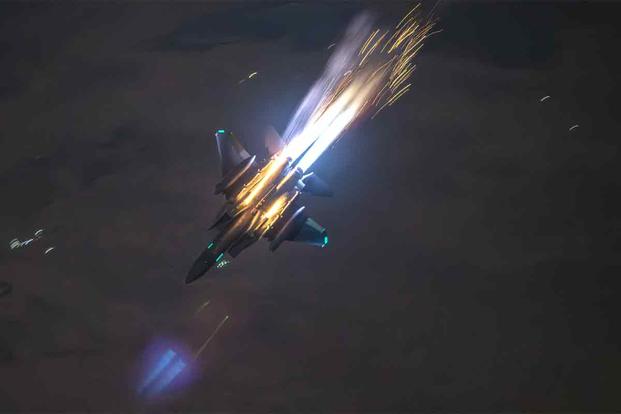

More than a month after announcing an indefinite bombing campaign against Houthi rebels in Yemen, the Defense Department has offered little information and the command overseeing the campaign is refusing to answer even basic questions on what U.S. forces have accomplished in the area or whether troops have been under fire or injured.
U.S. Central Command, which oversees all military operations in the Middle East, has spent the past 30 days making near-daily social media posts about its operations against the Houthis, but those posts have been little more than videos of flight operations on the aircraft carrier in the region and generic statements capped off with the hashtag “HouthisAreTerrorists.”
While some level of secrecy or information delay has always been part of military operations, the shift to actively refusing to provide even the most basic details about what service members are doing in a major military operation — the size of which has likely not been undertaken in years — is highly unusual. It’s also paired with a near-total lack of press briefings by the Pentagon’s top spokesman and a growing number of reports that the mission is not accomplishing any of its broader goals.
Read Next: Top Enlisted Leader at Air Force Special Operations Command Fired, Facing Investigation
Military.com asked U.S. Central Command this week to offer any details on accomplishments in the region and for basic data on its operations like number of missions flown, a summary of the ordinance dropped or targets that were hit.
In response, an official replied less than two hours later with a statement that said: “The U.S. has hit targets in Houthi-controlled parts of Yemen, destroying command and control facilities, weapons manufacturing facilities, and advanced weapons storage locations,” and it had “confirmed the death of several Houthi leader [sic].”
When asked follow-up questions on the claims or whether the combatant command was refusing to answer the questions, a different official simply re-sent the same statement minutes later and added a line: “We have nothing additional to provide at this time.”
The attitude is a notable departure from the command’s behavior under the Biden administration when it would regularly release updates on social media for the more than 100 strikes it conducted in Yemen since October 2023. While Central Command still insisted on withholding details such as the types of ordinance that was used, the posts included lists of targets hit by specific strikes and by what platforms, when U.S. warships were targeted and what Houthi assets were destroyed.
Those updates would also note whether any U.S. personnel were injured.
The last such update was posted on Dec. 31, 2024.
Despite lofty promises, Defense Secretary Pete Hegseth’s office has not been any better at offering insight into the Yemen military operation, now in its second month.
Just days before the campaign kicked off, the Pentagon’s top spokesman, Sean Parnell, posted a video in which he promised to offer weekly updates and “to be the most transparent DoD in American history for the warfighters and the American people.”
However, Parnell has only hosted one press conference since taking the job, compared to the Trump White House and State Department that have been providing regular public press briefings for months.
In his latest video update, Parnell only offered the following statement on the fighting in the Red Sea: “It’s been a bad three weeks for the Houthis and it’s about to get a lot worse.”
What few details that are public or that have been gleaned by journalists paint a picture of a campaign that seems to be racking up costs and expending valuable munition stocks but accomplishing little in its stated goal of reopening the Red Sea to merchant shipping.
CNN reported earlier this month that the operation’s costs were nearing $1 billion while having limited impact on destroying the Houthi’s capabilities.
The report noted that the strikes had used hundreds of millions of dollars of munitions that included Joint Air-to-Surface Standoff Missiles, or JASSMs, and Tomahawk long-range cruise missiles and Joint Standoff Weapons, or JSOWs — GPS-guided glide bombs.
Multiple outlets have also reported that the Houthis have managed to down several U.S. MQ-9 Reaper drones, which cost about $30 million each, since the campaign began.
Meanwhile, multiple reports noted that the air attacks are unlikely to be enough to defeat the Houthi rebels and may actually be emboldening them in the process.
Data on transits of the Suez Canal and a key chokepoint in the Red Sea also show that the weekslong campaign that has cost millions has done nothing to move the needle on the volume of merchant shipping that is moving through the area.
Salvatore Mercogliano, a maritime historian and former merchant mariner, told Military.com that he doesn’t see the shipping situation changing until insurance companies lower the cost of the “war risk insurance” that shipping companies have to pay to transit the area, and he’s seen little change that would convince the insurance firms to substantially lower rates.
Plus, at the same time, going around Africa instead of through the Red Sea is utilizing the extra cargo space the companies now have and that’s generating higher rates for them, he said.
“In a situation where insurance companies are making money for those ships transiting the Red Sea and shipping firms maintaining their profitability, there is little incentive to change the business operations,” Mercogliano said.
“Plus, if the Red Sea opens, we are going to have three months of chaos in ports, on top of Trump’s trade policies,” he added.
Central Command chose to not answer the question of whether there were any metrics it had that showed a positive impact on re-establishing shipping traffic in the Red Sea when asked by Military.com.
In the meantime, neither U.S. Central Command nor Hegseth’s office has offered any more details on what will prompt an end to operations.
During the single briefing Parnell held in late March, he told reporters that “there’s going to be … a very clear end state to this” without elaborating.
